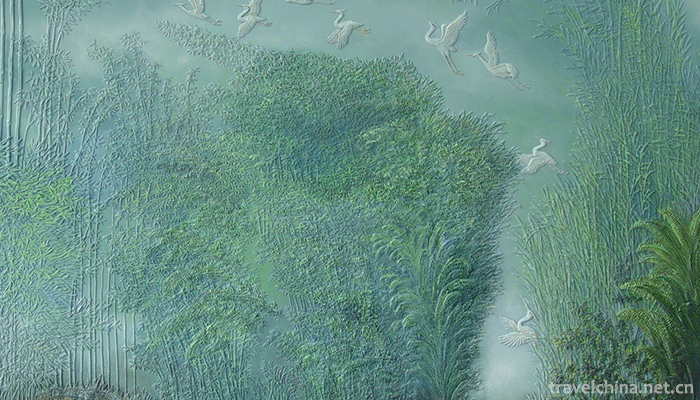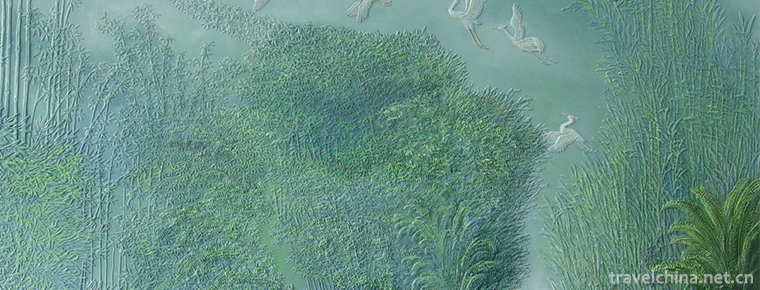Ou sculpture
Ou sculpture
Ou sculpture, commonly known as color oil-pickle sculpture, also known as "color relief", is a unique folk art in Wenzhou, Zhejiang Province, one of the local traditional arts and crafts. It is made of tung oil and mud, and is used to decorate temples, temple doors and folk dowry items, such as dressing boxes and furniture lacquerware, by means of moulding techniques. Originated in the Han Dynasty, it evolved from the stacking process in Chinese lacquerware art. It has rich colors, various techniques, wide subjects and unlimited specifications. It is widely used in architectural relief, murals, decorative patterns and artistic pendants. "Ou sculpture" and "Huangyang wood carving", "Dongyang wood carving" and "Qingtian stone carving" are also known as "Zhejiang three sculptures and one sculpture".
Ou Plastic is one of the first batch of "excellent traditional arts and crafts in Zhejiang" recognized by the Zhejiang Provincial Government, and the first batch of outstanding non-heritage tourism commodities in Zhejiang Province, is included in the scope of provincial key protection projects .
In 2006, it was listed in the first batch of intangible cultural heritage list of Zhejiang Province .
On June 7, 2008, Ou Plastic was listed in the second batch of national intangible cultural heritage list .
On May 21, 2018, Ou Plastic was listed in the first national catalogue of revitalization of traditional crafts
Technical features
The main theory of Western relief is "Compression by comparison", while the main theory of domestic relief is "Na Guang Na Yin". Skills flexibly absorb two different relief techniques, often the former expresses the high relief mainly with the face, the latter expresses the low relief mainly with the line; the former shapes the nearest and main body with fresh outline and prominent image in the picture, and the latter shapes the shallow prospect. Sometimes in order to highlight the main body, give people a sense of reality, and even shape the scenery into a round carving ritual visual effect.
In addition, compared with general relief, Ou sculpture also has a distinct feature, that is, it uses color to depict the intensity of light, the cold and warm tone of deep space, which greatly strengthens the artistic appeal of the picture. At this point, it is the same as western realistic oil painting method. The principle of light and color and the treatment of tone have become an indispensable artistic means in Ou plastic. Therefore, the Ou sculpture art is not only an ancient art, but also an outstanding young art. The precious and bold innovation of artists makes the Ou sculpture have a strong flavor of the times that other kinds of Arts can't match.
The wall sculptures of the Zhejiang Hall of the Great Hall of the People "West Lake Panorama" and "Yandang Autumn Landscape" are excellent works in Ou sculpture. These two representative Ou sculptures, the former is like a beautiful, quiet, affectionate girl, the latter is a magnificent, powerful, rough and bold hero. By using a series of expressive techniques, the creator highlights the comparative effects of quiet movement, softness and rigidity, cold and warm, thin and thick, and strong and weak, which fully reflects the exquisite skill and rich expressive means of Ou plastic art.
main features
Ou sculpture has the characteristics of free composition, clear layers, bright colors and strong three-dimensional sense.
The pictures are bright in color, free in composition, clear in layers and strong in three-dimensional sense. They are mostly used in large insert screens, hanging screens, multi-fan screen, wall clocks and small jewelry boxes, with the contents of flowers and birds, landscapes and opera characters. A distinctive feature of the new Ou sculpture technique is the organic combination of two different characteristics of art, sculpture and painting. It has the advantages of round sculpture and relief, so it is sculpture. It also absorbs the techniques of Western and Chinese painting, especially the principle of light and color to express three-dimensional, space, texture, etc. in Western painting. It melts sculpture and is good at painting.
Representative Works
"Qingming Shanghe Tu" is based on the famous painting of Zhang Choduan, a painter of the Northern Song Dynasty. With the rich texture and expressive power of oil mud, it enlarges the scene of Bianhe River in Kaifeng. The painting combines relief, oil painting and sketch, which not only retains the original charm, but also expands the tension of the painting space, with both shape and spirit, and is full of artistic appeal. Author Wu Xiaohong, graduated from China Academy of Fine Arts in 1962, is a master of Arts and crafts in Zhejiang Province.
"Golden Wenzhou" exaggerates the strong effect of the Ou sculpture "Pearl Gold Embossment", which allows the audience to examine from another angle the momentum of the Ou River flowing thousands of miles and the majesty of the flowing pillars, the towering mountains, the staggered buildings, the hundred rivers and rivers. Everything is enveloped in a warm golden tone, which is imaginative. The author is a craftsman, Zhu Guoguang. He is good at landscape theme. His works have won the excellent creation award of the First China Arts and Crafts Master Works Exhibition.


-
1.XiShuangBanNa Tropical Botanical GardenChines
Xishuangbanna Tropical Botanical Garden of the Chinese Academy of Sciences, National AAAAA Tourist Scenic Area, is located in Huludao, Mengla Town, Mengla County
Time 2018-12-12 -
2.China Coal Museum
The China Coal Museum is located at the intersection of Yingze Street and Jinci Road in Taiyuan City. It was completed and opened on September 30, 1989
Time 2018-12-22 -
3.Lion Peak in Meiling
Lion Peak in Meiling is a combination of Lion Peak, Panxi Lake and Wangshijian. The mountain is like a squatting lion, so it is called Lion Peak. Lion Peak in Meiling is only 260 meters
Time 2019-02-07 -
4.Stone Old Man Sightseeing Park
Shilao Sightseeing Park is located in Qingdao City to Laoshan Scenic Area, east of the fishing banquet in the Tang Dynasty, with an area of 1200 mu. Starting at the end of 1999
Time 2019-02-08 -
5.The tru Valley
Turugou is located in Liancheng Forest, Yongdeng County, 160 kilometers northwest of Lanzhou City. It belongs to the eastern foot of Qilian Mountains.
Time 2019-02-22 -
6.Donghe Opera
Donghe Opera, one of the national intangible cultural heritage, is a traditional drama in Donghe area of Ganzhou City, Jiangxi Province.
Time 2019-04-27 -
7.Nail twist Jiaru jiacuo
Jiaru is a traditional dance of Mosuo people in Lugu Lake, Yunnan Province. It is a song and dance for people to celebrate harvest, festivals and pray for gods.
Time 2019-05-05 -
8.Cutting Skill of Kaner Well
Kanerjing is the meaning of "well hole". It has been recorded as early as in Historical Records. It is called "well canal", while Xinjiang Uygur language is called "Kanerzi&qu
Time 2019-05-08 -
9.Manchu Ergui wrestling
Ergui wrestling is a traditional Manchu folk dance spread in the urban and rural areas of Longhua County, Hebei Province. It was formed in the late Qing Dynasty (around 1820 A.D.) and flourished betwe
Time 2019-05-17 -
10.Mongolian Horse Tool Making Skills
The Mongolian horse harness making technique is a handicraft in Horqin left-wing Houqi area of Inner Mongolia Autonomous Region. The production technology of horseback is accompanied by the "hors
Time 2019-06-05 -
11.Turkish Pan Embroidery
Pan embroidery is the most important embroidery method in Chinese Tu embroidery, and it is a compulsory course for Tu women in their lifetime. Pan embroidery is a unique embroidery method of the Tu na
Time 2019-06-23 -
12.Brewing Techniques of Fen Liquor in Xinghua Village
The brewing process of Fen liquor in Xinghua Village is complicated. Fen liquor in Xinghua Village is finally brewed through six main processes: grinding, moistening, steaming, fermentation, distillat
Time 2019-07-08